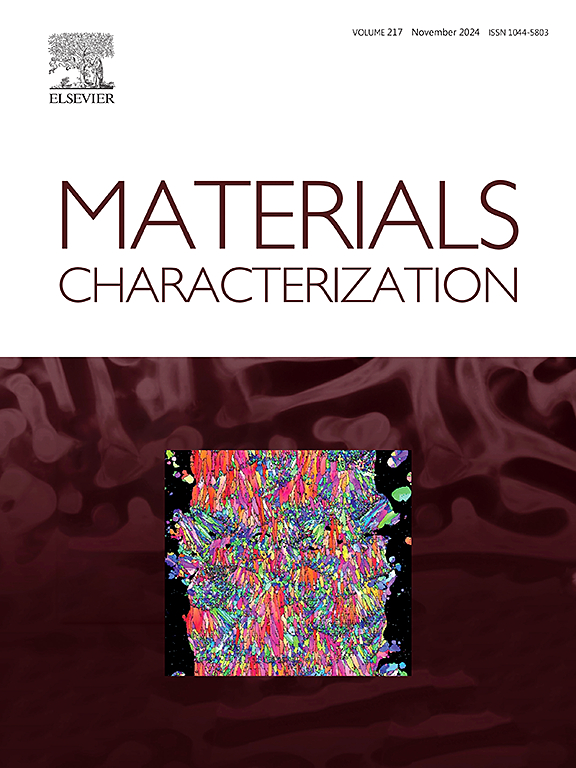热等静压和热处理对CM247LC合金裂纹愈合和强塑性增强的影响
IF 4.8
2区 材料科学
Q1 MATERIALS SCIENCE, CHARACTERIZATION & TESTING
引用次数: 0
摘要
高裂纹敏感性是高γ′体积分数镍基高温合金激光粉末床熔合的关键问题。本研究通过优化选择性激光重熔(SLRM)参数(激光功率:176 W,扫描速度:1143 mm/s,舱口间距:0.11 mm),结合热等静压(HIP: 1240°C/150 MPa/4 h)和热处理(HT: 1260°C固溶处理+870°C时效),系统分析了CM247LC合金的裂纹形成机制、熔池形态和显微组织演变。结果表明,裂纹主要沿高角度晶界扩展,裂纹的萌生与元素偏析(O、Al、C、Ti)和残余应力集中密切相关。将重熔体积能量密度(Ev)提高至56.8 J/mm3显著提高熔池深宽比(D/W = 0.62),加剧温度梯度和应力集中,从而提高裂纹敏感性。经SLRM + HIP + HT处理后,晶粒展弦比由7.32减小到3.66,锯齿状晶界和均匀分布的γ′相有效抑制裂纹扩展,降低残余应力。最终的试样表现出优异的强度-延性协同作用:极限抗拉强度为1352±16 MPa,屈服强度为988±25 MPa,伸长率为11.5±0.8%,与构建的选择性激光熔化样品相比,分别提高了23.0%,18.9%和79.7%。本文章由计算机程序翻译,如有差异,请以英文原文为准。
Crack healing and strength-ductility enhancement of CM247LC alloy via laser powder bed re-melting followed by hot isostatic pressing and heat treatment
High crack susceptibility remains a critical challenge in laser powder bed fusion of nickel-based superalloys with high γ'-volume fractions. This study systematically analyzes the crack formation mechanisms, melt pool morphology, and microstructural evolution of CM247LC alloy by optimizing selective laser re-melting (SLRM) parameters (laser power: 176 W, scan speed: 1143 mm/s, hatch spacing: 0.11 mm) combined with hot isostatic pressing (HIP: 1240 °C/150 MPa/4 h) and heat treatment (HT: 1260 °C solution treatment +870 °C aging). Results indicate that cracks primarily propagate along high-angle grain boundaries, with initiation closely linked to elemental segregation (O, Al, C, Ti) and residual stress concentration. Increasing the re-melting volumetric energy density (Ev) to 56.8 J/mm3 significantly enhances the melt pool depth-to-width ratio (D/W = 0.62), exacerbating temperature gradients and stress concentrations, thereby elevating crack susceptibility. After SLRM + HIP + HT treatment, the grain aspect ratio decreases from 7.32 to 3.66, while serrated grain boundaries and uniformly distributed γ'-phases effectively inhibit crack propagation and reduce residual stress. The final specimens exhibit exceptional strength-ductility synergy: ultimate tensile strength of 1352 ± 16 MPa, yield strength of 988 ± 25 MPa, and elongation of 11.5 ± 0.8 %, representing improvements of 23.0 %, 18.9 %, and 79.7 %, respectively, compared to the as-built selective laser melting samples.
求助全文
通过发布文献求助,成功后即可免费获取论文全文。
去求助
来源期刊

Materials Characterization
工程技术-材料科学:表征与测试
CiteScore
7.60
自引率
8.50%
发文量
746
审稿时长
36 days
期刊介绍:
Materials Characterization features original articles and state-of-the-art reviews on theoretical and practical aspects of the structure and behaviour of materials.
The Journal focuses on all characterization techniques, including all forms of microscopy (light, electron, acoustic, etc.,) and analysis (especially microanalysis and surface analytical techniques). Developments in both this wide range of techniques and their application to the quantification of the microstructure of materials are essential facets of the Journal.
The Journal provides the Materials Scientist/Engineer with up-to-date information on many types of materials with an underlying theme of explaining the behavior of materials using novel approaches. Materials covered by the journal include:
Metals & Alloys
Ceramics
Nanomaterials
Biomedical materials
Optical materials
Composites
Natural Materials.
 求助内容:
求助内容: 应助结果提醒方式:
应助结果提醒方式:


